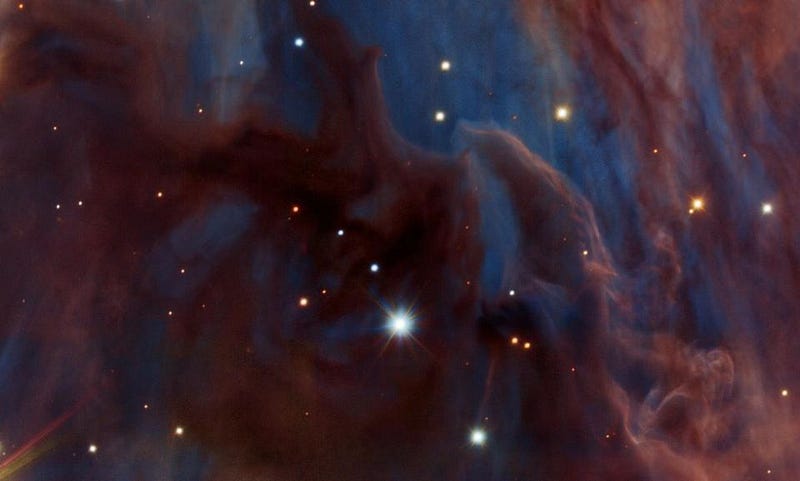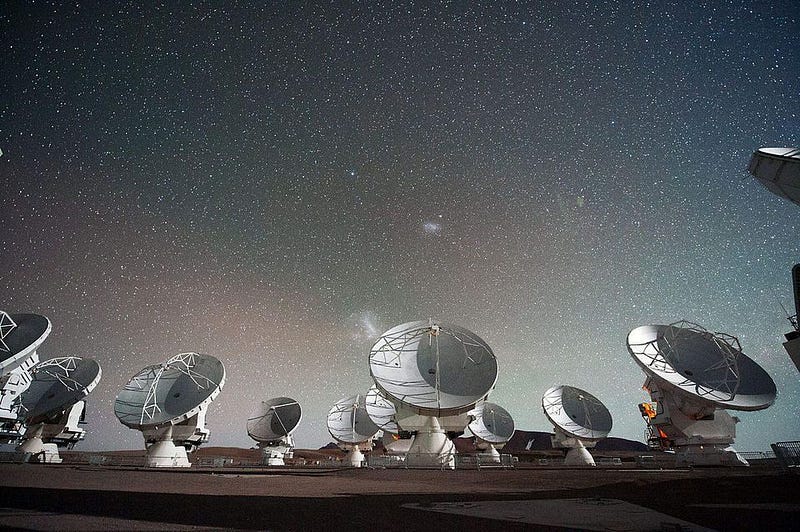Mysterious Light Seen Around A Newly Forming Star; Here’s What Astronomers Think It Means

In the search for the youngest planet in the Universe, astronomers may have accidentally stumbled upon something entirely new.
Growing up is hard to do in the Universe. In the great gravitational dance of the cosmos, it’s the biggest, most massive seeds that usually emerge victorious: attracting more and more matter towards them from whatever’s around. In a molecular cloud that forms stars, this usually means the largest-mass clumps grow into stars, while the remaining mass gets flattened into a disk. Within this disk, smaller clumps form, growing into planets, moons, and other icy and rocky bodies.
Looking at a protoplanetary disk around a young star holds the key to discovering how planets are formed. 600 light years away, the star CS Cha, in the small southern constellation of Chamaeleon, is a low-mass, binary star system in the process of forming. While looking for planets, scientists stumbled on something they’d never seen before. We’re still investigating, but it may turn out to be that we’re witnessing the birth of a brown dwarf: a failed star.

Wherever you have a molecular cloud of gas that’s massive enough, you have the potential to form a new star. If that cloud gets cool enough, it’ll start to collapse, with the largest initial imperfections attracting the most matter. CS Cha is one such newborn system, where the center region consists of a binary star system that’s in the process of forming. Surrounding the stars is a dusty disk: exactly what we’d expect for a newly-forming star system. Using the SPHERE instrument on the Very Large Telescope in Chile, they measured the system, its disk, and the surroundings in great detail. They were searching for new planets in general, but what they found appears to be even better than a newborn planet.

Normally, light from a star comes out unpolarized: the way the electric and magnetic fields of light are oriented is basically random. When light reflects off of anything, however, it becomes polarized. So the starlight is unpolarized, but the light from the protoplanetary disk should be polarized. And nearby that disk, in the infrared, a small object was also found. According to a new paper to be published in the journal Astronomy & Astrophysics, this object had the right brightness to either be a planet or a low-mass brown dwarf. The surprise, though, is that the light from this object, which should be emitting its own unpolarized radiation, turns out to be polarized after all.

If this were a gas giant planet or a brown dwarf, the light would be allowed to be slightly polarized: at about the 1% level. Astronomers have long-searched for this type of signal around systems like this, but to no avail. For the very first time, a polarization signature was detected around this tiny companion. But the level of polarization wasn’t at 1%, like we’d expect. Instead, it was literally astronomical: the polarization signature was at a whopping, unprecedented 14%! (There are slight variations from band-to-band.) There are very, very few objects in the Universe that can cause that much polarization, and so the team working on this, led by Christian Ginski, had to be extremely careful.

One idea that came to mind immediately was that this might not be a true companion of the system, but rather a distant background galaxy that emits highly polarized light. Active galaxies, where their supermassive black holes are presently feeding, devouring matter and spitting out tremendously energetic jets, can be polarized at this level. But Ginski’s team investigated that possibility by going to older data, taken by the Hubble Space Telescope years ago, to see if a signature of such a companion might be teased out. Although there wasn’t anything that appeared present, Hubble always has those pesky diffraction spikes due to its inherent design. While there will be a telescope without them in the near future, we presently have to use sophisticated processing techniques to remove them. So they did, and lo-and-behold, there was the companion.

If it were a background object, it wouldn’t appear to be in the same position years ago as it does today, due to the star’s proper motion across the skies. So this faint ball of highly polarized light truly turned out to be a companion to CS Cha. What does this mean? According to Ginski himself (emphasis added by me, in bold):
The most exciting part is that the light of the companion is highly polarized. Such a preference in the direction of polarization usually occurs when light is scattered along the way. We suspect that the companion is surrounded by [its] own dust disc. The tricky part is that the disc blocks a large part of the light and that is why we can hardly determine the mass of the companion.
What’s interesting about this is that not only does the data imply that the companion has its own disk, but that the disk is misaligned with the disk of the main, binary system!

In order to reproduce the signatures we see, the disk has to be practically edge-on to our line of sight. Which seems weird, because the main binary system that is CS Cha has a disk that’s inclined, somewhere between edge-on and face-on. This wouldn’t be the first time we’ve seen such a misalignment, as dusty, misaligned binary and trinary systems have been seen before. But it already marks the very first time we’ve detected a polarized companion outside of one of these protoplanetary disks! Because so much of the light is blocked by this dust disk, though, we have a hard time telling what the mass of this companion is. Is it a Jupiter-class planet? A super-Jupiter? Or, as the authors conjecture, is it a low-mass brown dwarf: a failed star?
With a dusty disk around the companion, there’s a near-certainty that whatever it is, it will be developing its own orbiting companions in the imminent future!

At an age of just 2-to-3 million years, not only aren’t we yet sure, but we’re not even sure this system is done forming. The SPHERE instrument on board the Very Large Telescope has hit its limits for what it can detect using infrared astronomy, but if we go to longer wavelengths and a different type of observatory, we should be able to find out once and for all. That’s why the team has follow-up observations planned using ALMA: the Atacama Large Millimeter/submillimeter Array.

A slew of additional questions arise when you start thinking about this system. Is the mass of the companion growing? Is the light coming from it changing over time? Are there planets forming in the disk around the main binary? Will the amount of polarization change as time goes on? The main disk around the binary system ends at about the distance from the Sun to Pluto’s aphelion, but the extended companion is about four times as far away. And as the authors conclude in their paper:
We find that the set of observations is best explained by a heavily extincted low mass (∼ 20 MJup) brown dwarf or high mass planet with an unresolved disk and dust envelope.
We could, for the first time, be observing a sub-stellar or planetary system in the process of forming: a scaled-up version of Jupiter and the Jovian moons. As we learn more information about this particular system and others like it, we’re on track to learn exactly how star systems form, evolve, and grow up in this Universe. It’s an incredible time to be looking up!
Ethan Siegel is the author of Beyond the Galaxy and Treknology. You can pre-order his third book, currently in development: the Encyclopaedia Cosmologica.





